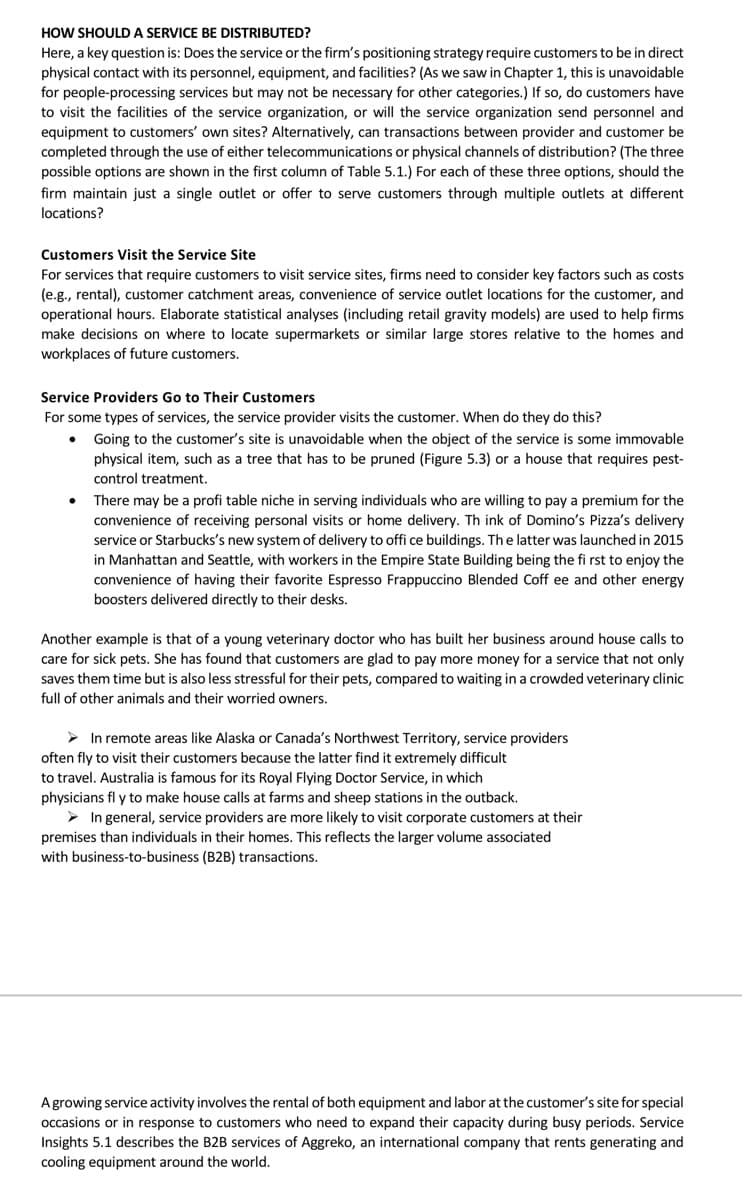Practical Management Science
6th Edition
ISBN:9781337406659
Author:WINSTON, Wayne L.
Publisher:WINSTON, Wayne L.
Chapter11: Simulation Models
Section11.4: Marketing Models
Problem 30P: Seas Beginning sells clothing by mail order. An important question is when to strike a customer from...
Related questions
Question
NOTE: Please explain what’s in the image, thank you.

Transcribed Image Text:HOW SHOULDA SERVICE BE DISTRIBUTED?
Here, a key question is: Does the service or the firm's positioning strategy require customers to be in direct
physical contact with its personnel, equipment, and facilities? (As we saw in Chapter 1, this is unavoidable
for people-processing services but may not be necessary for other categories.) If so, do customers have
to visit the facilities of the service organization, or will the service organization send personnel and
equipment to customers' own sites? Alternatively, can transactions between provider and customer be
completed through the use of either telecommunications or physical channels of distribution? (The three
possible options are shown in the first column of Table 5.1.) For each of these three options, should the
firm maintain just a single outlet or offer to serve customers through multiple outlets at different
locations?
Customers Visit the Service Site
For services that require customers to visit service sites, firms need to consider key factors such as costs
(e.g., rental), customer catchment areas, convenience of service outlet locations for the customer, and
operational hours. Elaborate statistical analyses (including retail gravity models) are used to help firms
make decisions on where to locate supermarkets or similar large stores relative to the homes and
workplaces of future customers.
Service Providers Go to Their Customers
For some types of services, the service provider visits the customer. When do they do this?
Going to the customer's site is unavoidable when the object of the service is some immovable
physical item, such as a tree that has to be pruned (Figure 5.3) or a house that requires pest-
control treatment.
There may be a profi table niche in serving individuals who are willing to pay a premium for the
convenience of receiving personal visits or home delivery. Th ink of Domino's Pizza's delivery
service or Starbucks's new system of delivery to offi ce buildings. Th e latter was launched in 2015
in Manhattan and Seattle, with workers in the Empire State Building being the fi rst to enjoy the
convenience of having their favorite Espresso Frappuccino Blended Coff ee and other energy
boosters delivered directly to their desks.
Another example is that of a young veterinary doctor who has built her business around house calls to
care for sick pets. She has found that customers are glad to pay more money for a service that not only
saves them time but is also less stressful for their pets, compared to waiting in a crowded veterinary clinic
full of other animals and their worried owners.
> In remote areas like Alaska or Canada's Northwest Territory, service providers
often fly to visit their customers because the latter find it extremely difficult
to travel. Australia is famous for its Royal Flying Doctor Service, in which
physicians fl y to make house calls at farms and sheep stations in the outback.
> In general, service providers are more likely to visit corporate customers at their
premises than individuals in their homes. This reflects the larger volume associated
with business-to-business (B2B) transactions.
Agrowing service activity involves the rental of both equipment and labor at the customer's site for special
occasions or in response to customers who need to expand their capacity during busy periods. Service
Insights 5.1 describes the B2B services of Aggreko, an international company that rents generating and
cooling equipment around the world.
Expert Solution
This question has been solved!
Explore an expertly crafted, step-by-step solution for a thorough understanding of key concepts.
Step by step
Solved in 5 steps

Recommended textbooks for you

Practical Management Science
Operations Management
ISBN:
9781337406659
Author:
WINSTON, Wayne L.
Publisher:
Cengage,

Practical Management Science
Operations Management
ISBN:
9781337406659
Author:
WINSTON, Wayne L.
Publisher:
Cengage,